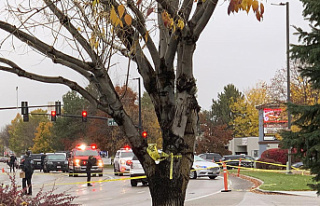Although the system moved south, it dropped enough rain Monday night to cause mudslides in the San Bernardino Mountains northeastern of Los Angeles.
The state's northern region was hit hard by torrential rains that caused flooding and rock slides. Strong winds blew down trees and toppled two large rigs at the Richmond-San Rafael Bridge in San Francisco. Pacific Gas & Electric reported that 380,000 homes lost power and most businesses had their power back on Monday.
Despite all the difficulties, rain and snow were welcomed in Northern California. This region is so dry that almost all of it has been classified as experiencing extreme or extraordinary drought. Wet weather reduces the likelihood of wildfires in areas that have already been ravaged by another year of devastating blazes.
According to the National Weather Service, preliminary rain totals were "staggering" with 11 inches (28 cmimeters), at Marin County's Mount Tamalpais, and 4 inches (10 cmimeters), in downtown San Francisco. This was the fourth-wettest ever day for the city.
The local weather office stated Monday that it was a memorable 24 hours in the Bay Area, as the much-respected atmospheric river rolled through. "We have literally gone from drought conditions to flooding in just one storm cycle."
Northeast of San Francisco, 5.44 in (13.82 cmimeters), fell on downtown Sacramento, breaking the 1880 one-day rainfall record.
Nearly 5.4 inches (13.72 centimeters), of rain were recorded along the central coast at California Polytechnic State University, San Luis Obispo County. Beverly Hills received 1.1 inches (2.79 cmimeters) of rain in Southern California.
Heavy snow on Monday morning closed Interstate 80, the main highway that runs through the Sierra Nevada Mountains and Reno, Nevada. The state Department of Transportation stated that state highways 16 in California's Yolo and Colusa counties were closed for several miles due to mudslides.
The same storm system also hit Washington and Oregon, causing power outages that affected thousands. Two people died when a tree fell onto a vehicle in Seattle.
According to the Department of Water Resource of California, Lake Oroville, a major reservoir in Northern California, saw its water levels increase 20 feet (6.10m) over the week. KHSL-TV reported that most of the increase occurred between Saturday and Monday during the worst of the storm.
Justin Mankin, Dartmouth College geography professor and co-lead for the Drought Task Force at National Oceanic and Atmospheric Administration said that the cycle of years-long droughts to record-breaking downpours can be expected to continue due to climate change.
Mankin stated that while rain is welcomed, it has its risks and won't end the drought. "California still requires more precipitation. It needs it at high elevations, spread over a longer period of time so it is not dangerous."
Chief of Sequoia National Parks' resource management and science, Christy Brigham, stated that the rain was a great relief after the Caldor Fire, which tore down thousands of cedars and pines in the park.
Brigham stated that this amount of rain is what we refer to as a season-ending event. It should end fire season and should eliminate our need to fight this fire to a large extent.
Caldor Fire has been burning for over two months. It triggered the unprecedented evacuation of South Lake Tahoe in September. Firefighters consider it now fully contained. This status, thanks to the rain, also applies to Dixie Fire which is the second-largest state fire in history, at just under 1,000,000 acres.
The California Highway Patrol shut down a section of State Route 70 between Plumas and Butte counties over multiple landslides caused by the huge Dixie Fire burn scar.
Cal Fire, the state's firefighting agency wasn't ready for the wildfire season to end or to reduce staffing to winter levels. Isaac Sanchez, a spokesperson for Cal Fire, stated that they would like to see more rain before we consider reducing staffing.
Mankin stated that California's long-term outlook shows dryr-than-normal conditions.
He said that to end the drought in different areas, it would be necessary for California to receive precipitation that is about 200% more than normal over the next three-months.









